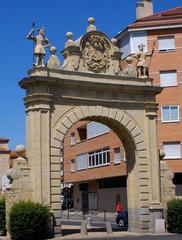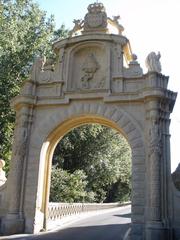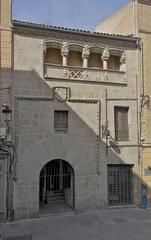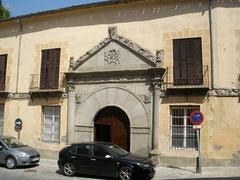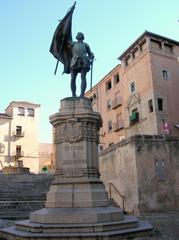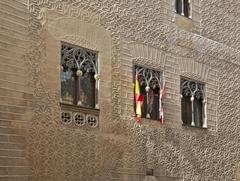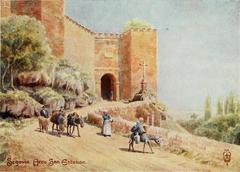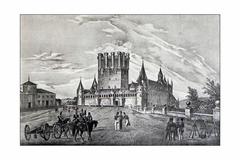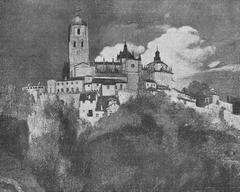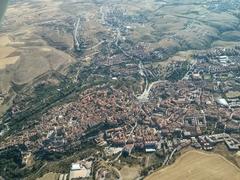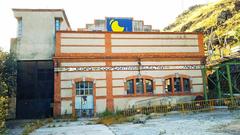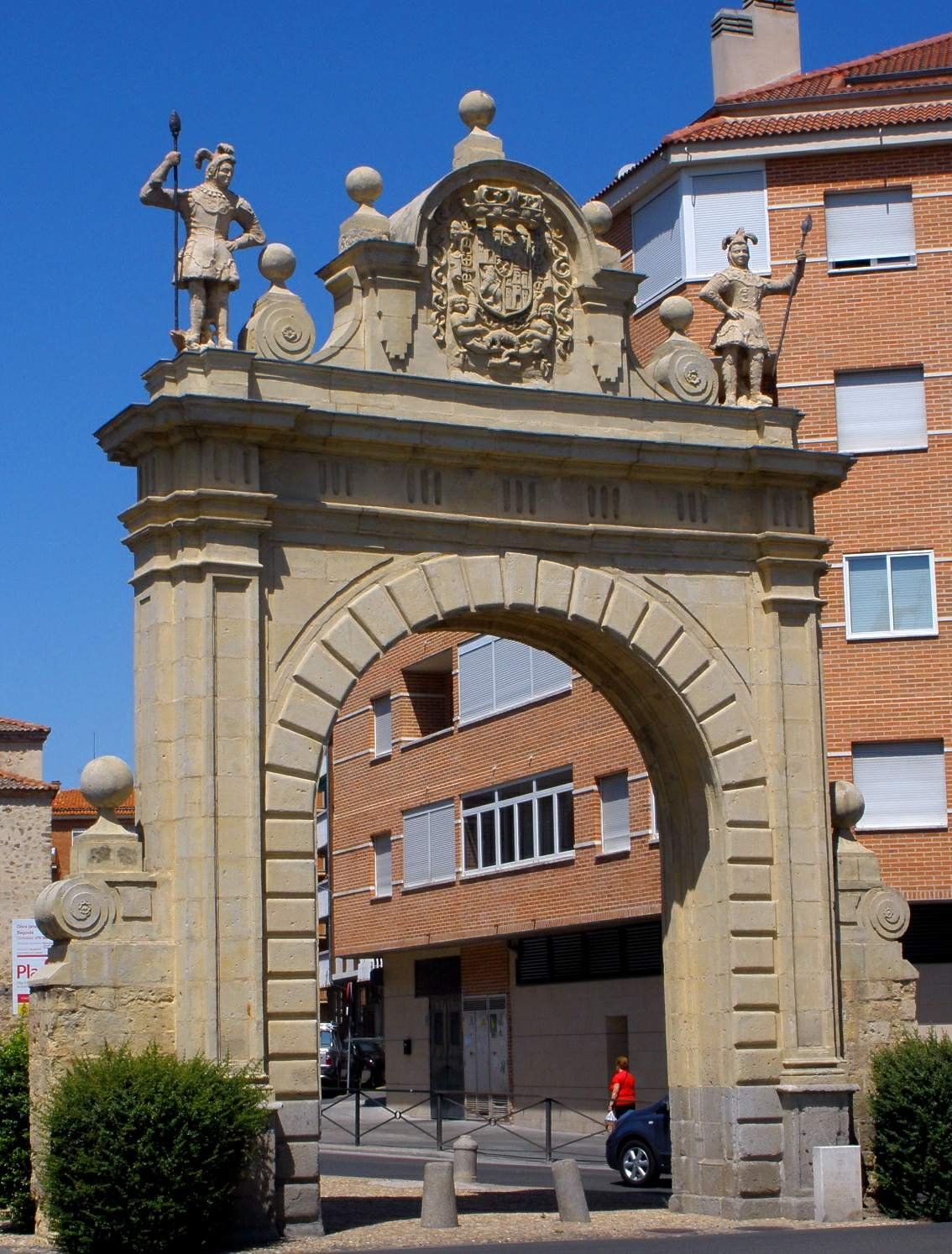
Puerta de Madrid Segovia: Visiting Hours, Tickets, and Travel Guide
Date: 14/06/2025
Introduction
Set within the medieval city walls of Segovia, Spain, the Puerta de Madrid is a compelling monument that offers visitors a direct portal to the city’s rich past. As one of the principal gateways of Segovia’s ancient fortifications, this stone gate was constructed between the 11th and 12th centuries to oversee access and protect the city—especially from the direction of Madrid, a vital route in Castilian history. Today, the Puerta de Madrid remains a significant part of Segovia’s UNESCO World Heritage ensemble, reflecting centuries of architectural evolution and the city’s multicultural heritage. This guide details all you need to know about visiting, including hours, ticketing, accessibility, nearby highlights, and practical tips for a memorable experience (Nomads Travel Guide, Touropia, World Heritage Sites).
Historical Background
Origins and Context
The Puerta de Madrid is one of several surviving gates from the Muralla de Segovia (Segovia’s medieval walls), which were constructed primarily in the 11th and 12th centuries. These fortifications provided security during the Reconquista and later political unrest. The gate’s strategic eastern location made it the primary entrance from Madrid, facilitating trade, military movements, and communication (Nomads Travel Guide, Touropia).
Architectural Features
The structure is notable for its robust granite and limestone masonry and a semicircular arch, with defensive features such as battlements and spaces for a portcullis. Its design prioritizes utility and defense, reflecting the martial needs of the time (Chasing the Long Road, Earth Trekkers). Restoration efforts over the centuries have preserved these defining characteristics, ensuring that visitors can appreciate its medieval authenticity (World Heritage Sites).
Civic and Symbolic Significance
Beyond its defensive role, Puerta de Madrid symbolized Segovia’s civic identity and loyalty to the Castilian crown. It served as a ceremonial entrance for dignitaries and was often adorned for public events. The gate also has a deep connection to Segovia’s multicultural history, lying near the Jewish Quarter and facilitating interaction between Christian, Jewish, and Moorish communities (World Heritage Sites).
Visitor Information
Location and Access
- Address: Calle de la Puerta de Madrid, 40003 Segovia, Spain
- Proximity: A short walk from the Roman Aqueduct, Plaza Mayor, and the Alcázar, making it a logical start or end point for a city tour (Nomads Travel Guide).
- Getting There: High-speed trains from Madrid to Segovia-Guiomar take under 30 minutes. Local buses or taxis connect the station to the old town.
Visiting Hours
- Open-Air Monument: Accessible 24 hours a day, year-round. There are no gates or barriers (The Tourist Checklist).
Tickets and Entrance Fees
- Free Access: Visiting the Puerta de Madrid is entirely free.
- City Wall Access: For a small fee (typically €2–€3), you can access the nearby city wall ramparts via the office at Puerta de San Andrés (Dancing Pandas).
Guided Tours
- Multiple companies offer guided walking tours that include Puerta de Madrid and other Segovia landmarks. These tours provide historical context and often start at or near the gate (Adventure in You).
Accessibility
- Pedestrian-Friendly: The approach to the gate is relatively flat, but nearby cobbled streets and slopes may challenge those with limited mobility.
- Wheelchair Access: Main access is manageable, though some sections of the city walls are less accessible.
On-Site Features
- Informational Plaques: Multilingual signs detail the gate’s history and architecture.
- Benches and Rest Areas: Available nearby for resting and enjoying the view.
Cultural and Historical Highlights
Key Events
The gate is closely linked to the Reconquista and specifically honors the Segovian troops who took part in the Christian reconquest of Madrid in 1083. Reliefs and statues around the site commemorate notable figures like captains Díaz Sanz and Fernán García (El Adelantado).
Multicultural Heritage
Puerta de Madrid is adjacent to the Jewish Quarter, reflecting Segovia’s historical diversity and the coexistence of Christian, Jewish, and Moorish communities (World Heritage Sites).
Modern Integration
The gate remains a focal point for Segovia’s festivals and historical reenactments, especially during medieval fairs. It is a popular subject for photographers and history lovers alike.
Nearby Attractions
- Roman Aqueduct: A UNESCO World Heritage marvel and Segovia’s most famous landmark.
- Plaza Mayor: Lively central square with shops, cafes, and historic architecture.
- Alcázar of Segovia: A fairytale castle with panoramic city views.
- Museo de Segovia: Offers deeper insight into the city’s history and culture.
- Jewish Quarter: Atmospheric streets and heritage sites nearby.
Practical Tips
- Best Times: Early morning or late afternoon for fewer crowds and optimal light.
- Footwear: Wear sturdy shoes for cobblestone streets and city wall walks.
- Weather: Summers can be hot, winters chilly—dress accordingly.
- Amenities: Cafés, restaurants, and restrooms are available within a short walk.
- Photography: The gate is particularly photogenic at sunrise or sunset.
Safety and Conduct
Puerta de Madrid and its environs are safe and well-maintained. Please respect preservation guidelines: do not climb on the monument or deface its surfaces, and dispose of litter appropriately.
Events and Seasonal Highlights
While Puerta de Madrid does not host regular events, it plays a central role in Segovia’s medieval festivals and cultural celebrations, often serving as a dramatic backdrop for parades and performances.
Frequently Asked Questions (FAQ)
Q: What are the Puerta de Madrid visiting hours?
A: The gate is accessible 24/7 as an open-air monument.
Q: Is there an admission fee?
A: No, visiting the gate is free. Only city wall access nearby requires a small ticket.
Q: Are guided tours available?
A: Yes, many walking tours include Puerta de Madrid; booking details are available at local tourist offices or online.
Q: Is the area accessible for people with disabilities?
A: The gate itself is accessible, though adjacent streets may be uneven.
Q: What are the best nearby attractions?
A: The Roman Aqueduct, Alcázar, Plaza Mayor, and the Jewish Quarter are all within walking distance.
Visuals and Interactive Resources
High-quality images and virtual tours can be found via the official Segovia Tourism Map.
Recommendations for an Enriched Visit
- Combine with Other Sites: Visit the Aqueduct, Alcázar, and city walls for a complete Segovia experience (PlanetWare).
- Museum Visits: Enhance your knowledge at Museo de Segovia and Real Casa de Moneda.
- Culinary Tips: Try traditional dishes like cochinillo (roast suckling pig) in local restaurants near Plaza Mayor.
- Photo Opportunities: For panoramic city shots, walk the city walls or visit Mirador de la Pradera de San Marcos.
Conclusion
The Puerta de Madrid stands as a vivid reminder of Segovia’s storied medieval past, serving as both a functional defensive structure and a powerful symbol of civic pride and multicultural heritage. Free to visit and open at all times, it offers a unique, immersive experience for all who pass through it. Whether as part of a guided tour or self-guided walk, this monument is an unmissable highlight in any Segovia itinerary.
For up-to-date information, special event details, and interactive maps, consult the official Segovia tourism website.
Sources
- Nomads Travel Guide - Segovia
- Touropia - Things to Do in Segovia
- World Heritage Sites - Old Town of Segovia
- The Tourist Checklist - Things to Do in Segovia
- Wanderlog - Most Historic Buildings and Sites in Segovia
- El Adelantado - La Puerta de Madrid
- Chasing the Long Road - Segovia
- Earth Trekkers - Segovia
- Dancing Pandas - Towns Near Madrid Spain Guide
- Adventure in You - Things to Do in Segovia
- PlanetWare - Segovia Attractions
For further planning, check with Segovia’s main tourist offices and the official tourism website.
